The Mind of the Supremes
M. Thorne May/June 2004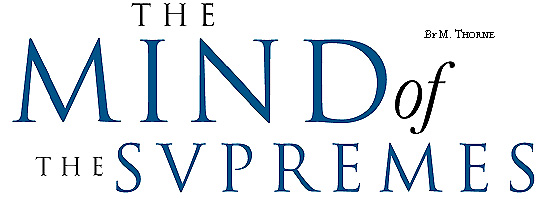
How have the current justices decided establishment clause cases in the past? That should give us a good idea as to how the Court will rule in upcoming cases such as Newdow. v. U.S. Congress.

- The intent of the Founders
- The Lemon test
- The special nature of public schools
- Longstanding traditions, our national heritage,
- ceremonial deism, and stare decisis.

Justice
William H. Rehnquist
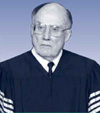
Justice Rehnquist dissented. He wrote that "the Ten Commandments have had a significant impact on the development of secular legal codes of the Western world." What a curious thing to say. While the idea that our law is somehow based on the Ten Commandments is popular, it is more myth than reality.
The Western world doesn't have laws that require people to put one god above all others; we don't have laws against using any god's name in vain; we don't prohibit people from working on Saturday. Our laws against murder and theft and adultery aren't derived from the Ten Commandments. They come to us from the founders of Western civilization: the Greeks and the Romans. In this case Rehnquist places a myth before the law.
Justifying his dissent in Stone, Rehnquist wrote, "The establishment clause does not require that the public sector be insulated from all things which may have a religious significance or origin." As we noted in the previous article, the Supreme Court has long held that the establishment clause requires government to be neutral toward religion, to not favor some religious beliefs over others. Does posting the Ten Commandments in public school classrooms exhibit such neutrality, or does it favor, say, Judaism over Hinduism?
The next case of interest is Wallace v. Jaffree, decided in 1985. The case was about an Alabama law that authorized a one-minute period of silence in public schools. It authorized public school teachers to lead "willing students" in prayer to "Almighty God . . .the Creator and Supreme Judge of the world." The Court relied on the purpose prong of the Lemon test to find the Alabama law unconstitutional.
Again Justice Rehnquist dissented. He attacked as a "misleading metaphor" the notion of a wall of separation between church and state. He dismissed the metaphor, even though the Court has relied on it since 1879. He concluded that the Lemon test should be abandoned, since it "has no more grounding in the history of the First Amendment than does the wall theory upon which it rests." In his dissent he showed his willingness to abandon longstanding precedent.
In Wallace Rehnquist offered an essay on the real meaning of the establishment clause. He concluded that the clause was "designed to stop the federal government from asserting a preference for one religious denomination or sect over others." Given that, would Rehnquist find that the Pledge of Allegiance asserts a preference for Jews over Hindus, for those who believe that there's only one God as compared with those who believe there are many gods?
Let's look at one more case, Santa Fe Independent School District v. Doe, decided in 2000. In this case the Court found it a violation of the establishment clause for prayers to be given before sporting events at a public school. Justice Rehnquist dissented. He wrote that the Court's decision "bristles with hostility to all things religious in public life." Since the prayer was given by the student body member who composed it, he concluded that it was private speech. He referred to a previous Supreme Court decision that said there was a "crucial difference between government speech endorsing religion, which the establishment clause forbids, and private speech endorsing religion, which the free speech and free exercise clauses protect."
This raises the question: Will Justice Rehnquist agree that the current version of the pledge is government speech endorsing religion, and is therefore unconstitutional? Of course not. In Santa Fe he wrote that the Court's opinion, with which he strongly disagreed, meant that adding "under God" to the pledge was unconstitutional. He'll certainly vote to overrule the appeals court's ruling in Newdow.
Justice
Sandra Day O'Connor
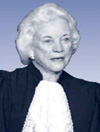
Consider what O'Connor has had to say about what the establishment clause prohibits:
- "What is crucial is that a government practice not have the effect of communicating a message of government endorsement or disapproval of religion."
- "Just as government may not favor particular religious beliefs over others, 'government may not favor religious belief over disbelief.'"
- "We have time and again held that the government generally may not treat people differently based on the God or gods they worship, or don't worship."
- "The establishment clause 'prohibits government from appearing to take a position on questions of religious belief.'"
- "It [the endorsement test] does preclude government from conveying or attempting to convey a message that religion or a particular religious belief is favored or preferred."
That last quote is revealing. In its controversial ruling in Newdow v. U.S. Congress, the appeals court found that "under God" in the pledge "is a profession of a religious belief, namely, a belief in monotheism." So we should expect O'Connor to uphold the appeals court's ruling, right? Maybe.
In Wallace v. Jaffree she wrote, "In my view, the words 'under God' in the pledge and opening court sessions with 'God save the United States and this honorable court' . . . serve as an acknowledgment of religion with 'the legitimate secular purposes of solemnizing public occasions, [and] expressing confidence in the future.'" What a curious thing to say!
In an earlier case she wrote that such practices as "the printing of 'In God We Trust' on our coins . . . serve, in the only ways reasonably possible in our culture, the legitimate secular purposes of solemnizing public occasions, expressing confidence in the future, and encouraging the recognition of what is worthy of appreciation in society. For that reason, and because of their history and ubiquity, those practices are not understood as conveying government approval of particular religious beliefs." What happened to the prohibition against government's even appearing to take a position on questions of religious belief, such as how many gods there are?
It's far from certain that imprinting our coins with a motto that reveals an official belief in any number of gods tends to solemnize public occasions. Let's say it does. Let's say it solemnizes the occasion of a class of first graders practicing their finger painting. Does solemnizing public occasions trump the prohibition against the government's taking a stand on religious beliefs, a prohibition the Court has long honored?
O'Connor also acknowledges the special nature of public schools. In Wallace she addressed the issue of "state-sponsored indoctrination" of religious beliefs in public schools and the perceptions of "children in their formative years." She agreed with the Court's opinion that the establishment clause prohibits "government-financed or government-sponsored indoctrination into the beliefs of a particular religious faith," and that "government inculcation of religious beliefs has the impermissible effect of advancing religion." She wrote, "This Court's decisions have recognized a distinction when government-sponsored religious exercises are directed at impressionable children who are required to attend school, for then government endorsement is much more likely to result in coerced religious beliefs."
In Newdow what might she say about a pledge to monotheism that children recite day after day, year after year? Would she find that state laws requiring daily recital of the pledge amount to government-sponsored indoctrination in a religious belief? Maybe.
Justice
John Paul Stevens

Stevens seems to think the establishment clause was meant to keep government and religion separate. His thinking is revealed by the quotes he uses from previous Court rulings to support his opinions. Here's a sampling:
- "The 'establishment of religion' clause of the First Amendment means at least this: Neither a state nor the federal government can set up a church. Neither can pass laws which aid one religion, aid all religions, or prefer one religion over another" (from Everson v. Board of Education, decided in 1947).
- "The place of religion in our society is an exalted one, achieved through a long tradition of reliance on the home, the church, and the inviolable citadel of the individual heart and mind. We have come to recognize through bitter experience that it is not within the power of the government to invade that citadel, whether its purpose or effect be to aid or oppose, to advance or retard. In the relationship between man and religion, the state is firmly committed to a position of neutrality" (from Abington School District v. Schempp, decided in 1963).
- "Neither [a state nor the federal government] can constitutionally pass laws or impose requirements which aid all religions as against non-believers, and neither can aid those religions based on a belief in the existence of God as against those religions founded on different beliefs" (from Torcaso v. Watkins, decided in 1961).
- "The law knows no heresy and is committed to the support of no dogma, the establishment of no sect" (from Watson v. Jones, decided in 1872).
- Do these quotes argue that it is appropriate for the Congress to enact laws based on a controversial religious belief? Or do they suggest that it is not the business of government to promote religious beliefs, that government lacks the authority to judge the truth of religious beliefs?
- Regarding the special nature of public schools, consider these excerpts from the Court's opinion, written by Stevens, in Santa Fe v. Doe: "School sponsorship of a religious message is impermissible because it sends the ancillary message to members of the audience who are nonadherents 'that they are outsiders, not full members of the political community, and an accompanying message to adherents that they are insiders, favored members of the political community.'"
- "We explained in Lee [referring to Lee v. Weisman] that the 'preservation and transmission of religious beliefs and worship is a responsibility and a choice committed to the private sphere.'"
- "Even if we regard every high school student's decision to attend a home football game as purely voluntary, we are nevertheless persuaded that the delivery of a pregame prayer has the improper effect of coercing those present to participate in an act of religious worship. For 'the government may no more use social pressure to enforce orthodoxy than it may use more direct means.'"
- "As in Lee, 'what to most believers may seem nothing more than a reasonable request that the nonbeliever respect their religious practices, in a school context may appear to the nonbeliever or dissenter to be an attempt to employ the machinery of the state to enforce a religious orthodoxy.'"
Based upon such comments as these, should we assume that Stevens will uphold the appeals court's decision in Newdow? Maybe.

Justice
Antonin Scalia

- "I doubt whether that 'purpose' requirement of Lemon is a proper interpretation of the Constitution" (from Edwards v. Aguillard, decided in 1987).
- "Our religion clause jurisprudence has become bedeviled (so to speak) by reliance on formulaic abstractions [e.g., the Lemon test] that are not derived from, but positively conflict with, our long-accepted constitutional traditions" (from Lee v. Weisman, decided in 1992).
- "For my part, I agree with the long list of constitutional scholars who have criticized Lemon and bemoaned the strange establishment clause geometry of crooked lines and wavering shapes its intermittent use has produced" (from Lamb's Chapel v. Center Moriches School District, decided in 1993).
The crooked lines he refers to are those the Court has drawn to satisfy the purpose prong. While Justice O'Connor writes, "We cannot avoid the obligation to draw lines, often close and difficult lines, in deciding establishment clause cases," and Justice Anthony Kennedy writes, "Our jurisprudence in this area is of necessity one of line-drawing," Justice Scalia rejects all that and says that drawing these lines leads to such unreasonable results as Nativity scenes on public property sometimes being considered constitutional, sometimes not.
While Justice O'Connor has searched for a test that can be applied consistently, Justice Scalia says the Lemon test has left it unclear what the establishment clause prohibits and what it allows. In one of his opinions Scalia put it this way:
- "Our cases interpreting and applying the purpose test have made such a maze of the Establishment Clause that even the most conscientious governmental officials can only guess what motives will be held unconstitutional" (from Edwards v. Aguillard).
- In another opinion Scalia mocked the test:
- "As to the Court's invocation of the Lemon test: like some ghoul in a late-night horror movie that repeatedly sits up in its grave and shuffles abroad after being repeatedly killed and buried, Lemon stalks our establishment clause jurisprudence once again" (from Lamb's Chapel v. Center Moriches School District).
Scalia says he would replace the Lemon test with some other measure that maintains "fidelity to the longstanding traditions of our people." Like Rehnquist, Scalia makes many references to tradition in establishment clause cases. Consider the case of Lee v. Weisman, in which the Court ruled that it violated the establishment clause for public schools to have clerics lead prayers at graduation ceremonies. In his dissent Scalia said the Court's decision "lays waste a tradition that is as old as public school graduation ceremonies themselves." He noted the "longstanding American tradition of nonsectarian prayer to God at public celebrations," and he said, "The longstanding American tradition of prayer at official ceremonies displays with unmistakable clarity that the establishment clause does not forbid the government to accommodate it."
In short, if something has been allowed long enough, it must be constitutional; else it would not have been allowed for so long. (We should be thankful that Scalia was not on the Court when Brown v. Board of Education was decided.) This raises an interesting question: How long is long enough? Fifty years? Another interesting question arises from Scalia's comments: If longstanding traditions are inherently constitutional, how is it that longstanding Court precedents—such as the Lemon test—are to be mocked? (Perhaps Scalia is living testimony against O'Connor's belief that opening the Court with a plea to a god solemnizes the occasion.)
One final observation about Scalia's dissent in Lee v. Weisman. Scalia noted that the Court's decision meant that the current version of the Pledge of Allegiance is unconstitutional. Sarcastically he said that finding the pledge unconstitutional "ought to be the next project for the Court's bulldozer." Might that turn out to be a prophetic comment?
Justice
Anthony M. Kennedy
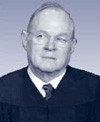
Consider the case of Allegheny County v. ACLU, in which the Court found that a Nativity scene in a county courthouse violated the establishment clause. Kennedy took the opportunity to discuss the application of such tests to the current version of the pledge. He wrote that "it borders on sophistry to suggest that the 'reasonable' atheist would not feel less than a 'full member of the political community' every time his fellow Americans recited, as part of their expression of patriotism and love for country, a phrase he believed to be false." Given the "bizarre results" that come from these tests, he said he'd rather take the strict separationist view: Let's just eliminate all religious displays on public property and be done with it.
In Allegheny Kennedy said the local community should decide what are appropriate displays for a religious holiday: "In my view the principles of the establishment clause and our nation's historic traditions of diversity and pluralism allow communities to make reasonable judgments respecting the accommodation or acknowledgment of holidays with both cultural and religious aspects. No constitutional violation occurs when they do so by displaying a symbol of the holiday's religious origins."
This raises some interesting questions. What if the local community happens to be New York City, a community with many different cultural and religious groups? Kennedy's prescription may work if the entire community belongs to one religion, but what about real communities? What about religious minorities in real communities? Consider the situation of a Catholic family living in a predominantly Muslim community. The children attend public school in the community. What are they to do when the teacher leads the class in a pledge to "one nation under Allah"? What are they to do when the class breaks for afternoon prayers?
Like Scalia, Kennedy feels that establishment clause rulings lack consistency. He says the Court's rulings should be consistent with "historical practices that, by tradition, have informed our First Amendment jurisprudence." In Kennedy's opinion, no matter what test the Court uses in establishment clause cases, "the reference to God in the Pledge of Allegiance . . . the Court will not proscribe." But he gives no reason at all for such a refusal. Is there something in the Constitution that says any practice that's been accepted for X number of years is exempt from constitutional scrutiny? If so, what is the value of X? If it is 50 years, then the appeals court's decision can be upheld only if the Court decides Newdow before Flag Day, 2004. After that, it becomes exempt.
Consider another quote from Kennedy:
- "The First Amendment's religion clauses mean that religious beliefs and religious expression are too precious to be either proscribed or prescribed by the state. The design of the Constitution is that preservation and transmission of religious beliefs and worship is a responsibility and a choice committed to the private sphere, which itself is promised freedom to pursue that mission."
- How does that jibe with a refusal to proscribe the "reference to God in the Pledge of Allegiance"? If the state cannot prescribe religious beliefs, shouldn't the appeals court's decision be upheld? Shouldn't Congress be barred from passing laws that endorse controversial religious beliefs?
- Like O'Connor and Stevens, Kennedy considers the special nature of public education. Consider these excerpts from his opinions:
- "No holding by this Court suggests that a school can persuade or compel a student to participate in a religious exercise. That is being done here, and it is forbidden by the establishment clause of the First Amendment" (from Lee v. Weisman).
- n "The injury caused by the government's action, and the reason why Daniel and Deborah Weisman object to it, is that the state, in a school setting, in effect required participation in a religious exercise."
- "We think the state may not, consistent with the establishment clause, place primary and secondary school children in this position [of participating in a religious exercise unwillingly, or of protesting]."
- "What to most believers may seem nothing more than a reasonable request that the nonbeliever respect their religious practices, in a school context may appear to the nonbeliever or dissenter to be an attempt to employ the machinery of the state to enforce a religious orthodoxy."
How will Kennedy vote in Newdow? Hard to tell. Judging from his opinions, he could go either way. His decision might depend on the arguments presented by Newdow and by those arrayed against him: the United States, the attorneys general of 50 states, a number of religious rights organizations, a school district, and public opinion.
Justice
Clarence Thomas

Speculating as to what James Madison intended by the establishment clause, Thomas wrote, "Madison saw the principle of nonestablishment as barring governmental preferences for particular religious faiths." From that, might we suppose that Thomas would vote to uphold the appeals court's decision, as the pledge's wording prefers particular religious faiths, i.e., those that hold there is but one god? Not likely.
Justice
Stephen G. Breyer

- "The First Amendment begins with a prohibition, that 'Congress shall make no law respecting an establishment of religion,' and a guarantee, that the government shall not prohibit 'the free exercise thereof.' These clauses embody an understanding, reached in the seventeenth century after decades of religious war, that liberty and social stability demand a religious tolerance that respects the religious views of all citizens, permits those citizens to 'worship God in their own way,' and allows all families to 'teach their children and to form their characters as they wish.'"
- "The upshot [of twentieth-century establishment clause cases] is the development of constitutional doctrine that reads the establishment clause as avoiding religious strife, not by providing every religion with an equal opportunity (say, to secure state funding or to pray in the public schools), but by drawing fairly clear lines of separation between church and state—at least where the heartland of religious belief, such as primary religious education, is at issue."
- "In a society as religiously diverse as ours, the Court has recognized that we must rely on the religion clauses of the First Amendment to protect against religious strife, particularly when what is at issue is an area as central to religious belief as the shaping, through primary education, of the next generation's minds and spirits."
Newdow says the existing pledge deprives him of his right to raise his daughter as he wishes, that the state is competing with him when it comes to his daughter's religious upbringing. If he makes that argument before the Court, look for Breyer to vote in Newdow's favor.

Justice
David Hackett Souter
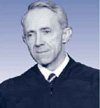
Consider these excerpts from Souter's opinions about the rights of nonbelievers, such as the plaintiff in Newdow:
- "The First Amendment mandates governmental neutrality between religion and religion, and between religion and nonreligion."
- "Neither a state nor the federal government . . . can constitutionally pass laws or impose requirements which aid all religions as against nonbelievers."
- "The state may not favor or endorse either religion generally over nonreligion or one religion over others."
- "The political interest in forestalling intolerance extends beyond intolerance among Christian sects—or even intolerance among 'religions'—to encompass intolerance of the disbeliever and the uncertain."
- "The establishment clause applies 'to each of us, be he Jew or agnostic, Christian or atheist, Buddhist or freethinker.'"
Slam dunk! Anyone who thinks that listening to a prayer at a high school graduation ceremony is an unconstitutional form of coercion is sure to find that having to recite a pledge acknowledging there's only one god, and doing it more than 2,000 times before graduation, is a much more serious form of coercion, right?
Justice
Ruth Bader Ginsburg
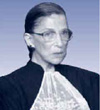
Conclusion
When the Newdow ruling was first announced, the public was anxious about it, but then lots of constitutional scholars appeared on TV. "The Supreme Court will surely overrule this decision," they said. And they gave all sorts of reasons. The pledge has called this a nation "under God" for 50 years, but that hasn't resulted in a national religion. The reference to God in the pledge doesn't advance a religion or a religious belief. It's just an acknowledgment of our nation's religious heritage. It merely acknowledges the fact that the people who wrote our Constitution believed this to be a nation under God. Besides, it's a cultural fact—as Ted Olson, U.S. solicitor general, claims—that we're a "religious people whose institutions presuppose a Supreme Being."
But an analysis of how the current Supreme Court justices have ruled, and a review of the opinions they've expressed in cases involving the establishment clause and public education, leave it far from certain that they'll overrule the appeals court. In fact, it provides strong evidence that they'll uphold the appeals court.
In Lee v. Weisman Justices O'Connor, Kennedy, Stevens, and Souter agreed that having a cleric say a prayer at a graduation ceremony coerced students to participate in a religious exercise. From that, it's not hard to see those four agreeing with the appeals court ruling. It's not hard to see Justices Breyer and Ginsburg agreeing with the ruling as well. It's easy to see Justices Rehnquist, Scalia, and Thomas voting to overrule the appeals court, based on their dissent in Lee as well as their opinions in other cases. That leaves us with a likely 6 - 3 decision in favor of upholding the appeals court ruling. That is, until we consider that Justice Scalia is going to sit this one out.
Since Justice Scalia made references to this case in a speech he made earlier this year, and since Michael Newdow did what experienced lawyers never do, he asked a Supreme Court justice to recuse himself or herself from a case—Scalia is out. That means eight j